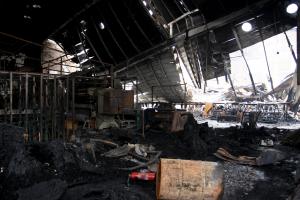— Earl Carr, Jr.
HAMMOND, LA, UNITED STATES, October 11, 2024 /EINPresswire.com/ — Fire damage can have a devastating impact on both residential and commercial properties. Once the flames have been extinguished, the real challenge of restoration begins. The aftermath of a fire leaves behind not only structural damage but also extensive issues caused by soot, smoke, and heat. Effective fire damage mitigation is critical to restoring a property to its pre-fire condition and minimizing long-term effects. Earl Carr, Jr., president of Gulf 52, a restoration company in Hammond, Louisiana, provides expert insight into the complexities of fire damage and the best practices for dealing with these types of damage.
The process of mitigating fire damage requires a thorough understanding of how heat, smoke, and soot interact with various surfaces and materials. Each type of damage presents unique challenges, and addressing them effectively requires a combination of specialized techniques, tools, and expertise.
“Fire damage is not just about what the flames consume,” says Carr. “It’s about how heat alters the structural integrity of materials, how soot contaminates surfaces, and how smoke infiltrates areas that flames may not have reached.”
Soot Damage: Assessing and Cleaning Surfaces
One of the most immediate and visible consequences of a fire is soot. Soot is a byproduct of the combustion process and consists of tiny carbon particles that become airborne during a fire. It can quickly spread throughout a property, settling on surfaces, furniture, and personal belongings. This fine residue is not only unsightly but also potentially hazardous, as it contains harmful chemicals and can cause respiratory issues.
When dealing with soot damage, it is crucial to act quickly to prevent the particles from embedding further into materials. Soot is acidic and can cause corrosion, staining, and etching on surfaces like metal, glass, wood, and fabrics. The type of soot and the materials it affects will determine the appropriate cleaning methods. In some cases, dry-cleaning techniques are used to remove the loose residue, while in others, specialized chemical sponges or cleaning agents are required to lift and neutralize the soot.
The restoration process often involves a combination of vacuuming, brushing, and wiping down surfaces, followed by more thorough cleaning to ensure that all traces of soot are effectively removed. Soot damage can be especially tricky because it may not be limited to areas directly affected by the flames; it can be transported through the air and HVAC systems, contaminating spaces far from the original fire site.
Smoke Damage: Odor and Air Quality Control
Smoke damage is another pervasive issue after a fire. Unlike soot, which is visible, smoke particles are often invisible but can infiltrate porous materials such as drywall, insulation, upholstery, and even clothing. This can lead to persistent odors and long-term contamination of the indoor environment. Smoke is also highly acidic, which can damage electronics, metals, and other sensitive items over time.
To address smoke damage, odor neutralization and air quality control are primary objectives. This involves using techniques like thermal fogging, ozone treatments, and hydroxyl generators to break down and neutralize the smoke particles embedded in materials. Air scrubbers equipped with high-efficiency particulate air (HEPA) filters are also employed to clean the air and remove airborne contaminants.
The timing of smoke mitigation is critical, as the longer the smoke particles are allowed to settle and permeate materials, the harder they are to remove. Restoration professionals must carefully assess the type and extent of smoke damage to select the appropriate treatment methods.
Heat Damage: Structural and Material Concerns
The heat generated during a fire can cause a wide range of damage to both the structure of the building and its contents. High temperatures can warp, melt, or weaken materials like wood, metal, plastics, and glass. In some cases, intense heat can cause windows to crack or shatter, roofing materials to buckle, and walls to lose their integrity.
Addressing heat damage often requires structural assessments to ensure the stability of the property. Any materials that have been compromised by heat must be repaired or replaced to restore the building’s safety. In addition, heat damage can impact electrical wiring, plumbing, and other essential systems within a building, requiring professional inspections and potential repairs.
Restoring heat-damaged materials often involves reinforcing structural components, replacing weakened elements, and ensuring that all building systems are safe and functional. The restoration process may require collaboration between various specialists, including electricians, carpenters, and roofing professionals, to fully restore the property.
Comprehensive Fire Damage Mitigation
Effective fire damage mitigation requires a coordinated approach to address all aspects of the damage: soot, smoke, and heat. Professionals in the restoration industry understand the importance of a quick response, as immediate action can prevent further damage, reduce restoration costs, and ensure the safety and health of the property’s occupants.
The first step is often securing the property to prevent additional damage from weather exposure, vandalism, or other external factors. Once secured, an assessment is conducted to evaluate the extent of soot, smoke, and heat damage. This evaluation guides the selection of cleaning techniques, restoration methods, and any necessary repairs.
For soot and smoke, the goal is to remove all contaminants from surfaces, neutralize odors, and improve air quality. For heat damage, the focus is on ensuring the structure’s integrity and restoring any materials or systems that have been compromised. This process is methodical and often requires multiple stages to ensure that all damage is fully addressed.
The Role of Professional Expertise
Fire damage restoration is a specialized field that requires both technical knowledge and experience. Dealing with the different types of damage effectively demands an understanding of how fire, soot, and smoke interact with various materials and the best practices for mitigating their effects. A professional restoration company like Gulf 52 brings expertise, proper equipment, and a clear process to the table, ensuring that each property is restored efficiently and thoroughly.
Morgan Thomas
Rhino Digital, LLC
+1 504-875-5036
email us here
Visit us on social media:
Facebook
Legal Disclaimer:
EIN Presswire provides this news content “as is” without warranty of any kind. We do not accept any responsibility or liability
for the accuracy, content, images, videos, licenses, completeness, legality, or reliability of the information contained in this
article. If you have any complaints or copyright issues related to this article, kindly contact the author above.
![]()
Originally published at https://www.einpresswire.com/article/751025251/fire-damage-mitigation-addressing-soot-smoke-and-heat-damage


